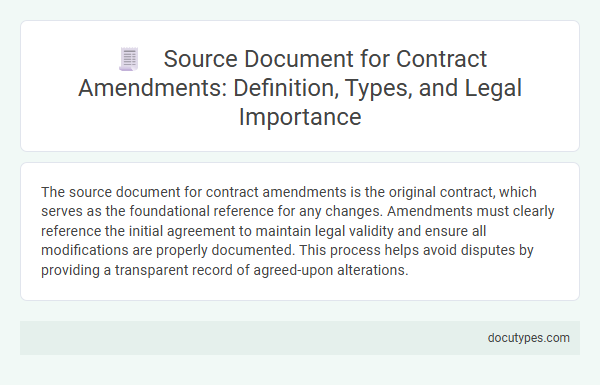The source document for contract amendments is the original contract, which serves as the foundational reference for any changes. Amendments must clearly reference the initial agreement to maintain legal validity and ensure all modifications are properly documented. This process helps avoid disputes by providing a transparent record of agreed-upon alterations.
Introduction to Source Documents in Contract Amendments
Source documents play a crucial role in contract amendments by providing the original terms and relevant details necessary for accurate changes. These documents serve as the foundation for any modifications, ensuring clarity and legal validity.
You should always refer to the initial contract and related communications when preparing amendments. Proper use of source documents helps prevent disputes and maintains consistency throughout the contract lifecycle.
Defining Source Documents for Contract Amendments
The source document for contract amendments is the original contract or agreement that outlines the initial terms and conditions. It serves as the foundation for any modifications, ensuring all changes are accurately referenced and legally binding.
- Original Contract - The primary document that defines the initial obligations and provisions between parties.
- Amendment Agreement - A formal document referencing the original contract to specify the alterations or additions.
- Supporting Documentation - Additional records such as correspondence or approvals that justify and validate the amendment.
Key Types of Source Documents Used in Contract Modifications
Source documents for contract amendments provide the foundational evidence required to update, clarify, or modify existing contractual agreements. Identifying the correct type of document ensures accurate and legally binding contract modifications.
- Amendment Agreement - A formal written document signed by all parties that outlines specific changes to the original contract terms.
- Change Order - An official directive used mainly in construction and service contracts to authorize and document modifications in scope, cost, or schedule.
- Written Correspondence - Emails or letters between contracting parties that confirm agreed-upon changes and act as proof for contract amendments.
Legal Importance of Accurate Source Documentation
What is the source document for contract amendments? The source document for contract amendments is typically the original contract or agreement along with any formal amendment documents that detail the changes. Accurate source documentation is legally important because it ensures clarity, prevents disputes, and provides a clear record of all modifications made to the contract.
Common Examples of Source Documents for Amendments
Source documents for contract amendments serve as the original references that validate and authorize changes within a contract. Common examples include change orders, written consent forms, emails confirming agreement modifications, and updated scope statements. You should always ensure these documents are clearly linked to the amendment to maintain legal clarity and enforceability.
How Source Documents Support Contractual Changes
Source documents for contract amendments are the original agreements, related correspondence, and formal modification proposals that provide the basis for any changes. These documents validate the legitimacy and details of the amendments, ensuring clarity and legal compliance throughout the contract lifecycle.
- Original Contract - Serves as the foundational reference outlining the terms and conditions before any modifications.
- Amendment Proposals - Contain detailed descriptions and justifications for the requested contractual changes.
- Correspondence Records - Capture negotiations and approvals critical to validating the amendment process.
Proper source documents support contractual changes by providing verifiable evidence that safeguards both parties and maintains contract integrity.
Regulatory and Compliance Considerations
The source document for contract amendments is typically the original contract combined with any approved amendment agreements. Regulatory bodies require clear documentation to ensure all changes comply with relevant laws and standards.
Your contract amendments must align with industry regulations, such as GDPR or HIPAA, to avoid legal penalties. Compliance teams often review amendments to verify that modifications meet regulatory guidelines. Maintaining accurate source documents supports audit trails and fosters transparency during contract management.
Risks of Inadequate Source Documentation
| Topic | Details |
|---|---|
| Source Document for Contract Amendments | Official records such as signed amendment agreements, original contracts, written correspondence, and formal change orders serve as the primary source documents for contract amendments. |
| Importance of Source Documentation | Accurate, well-maintained source documents ensure clarity on the terms modified, provide legal proof of changes, and facilitate audit trails. |
| Risks of Inadequate Source Documentation |
|
| Best Practices | Maintain a centralized repository of all contract amendments, use standardized templates for changes, and ensure timely updating and approval of relevant documentation. |
Best Practices for Managing Source Documents
The source document for contract amendments is the original contract or agreement from which changes are officially derived. It serves as the authoritative reference point for all modifications and ensures consistency throughout the contracting process.
Best practices for managing source documents include maintaining a clear version history and securely storing all related files to prevent unauthorized access or loss. Proper documentation and systematic tracking enable efficient review and validation of contract amendments.
What Is the Source Document for Contract Amendments? Infographic

